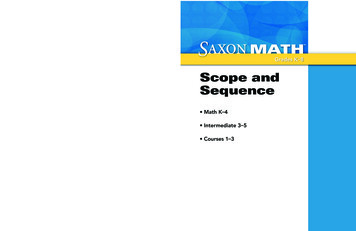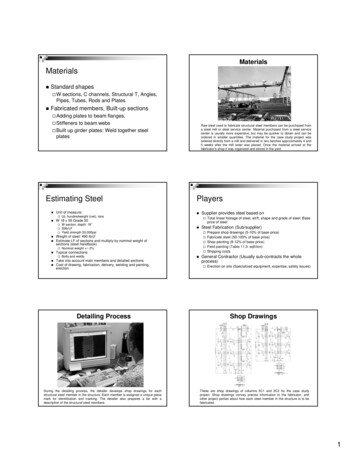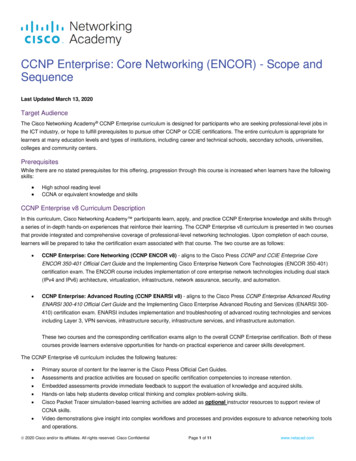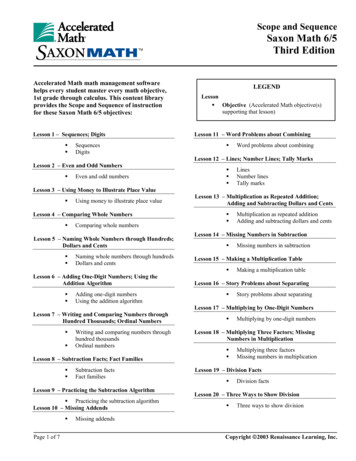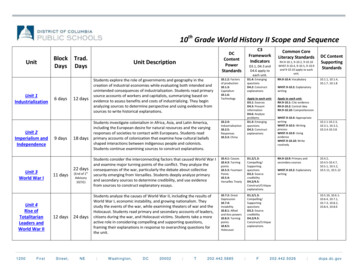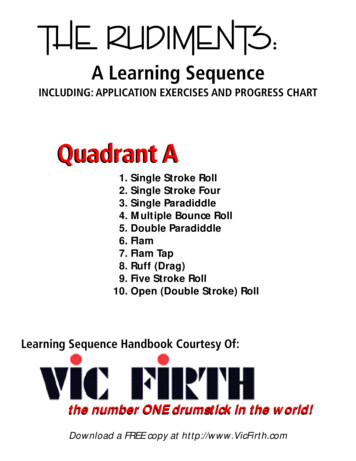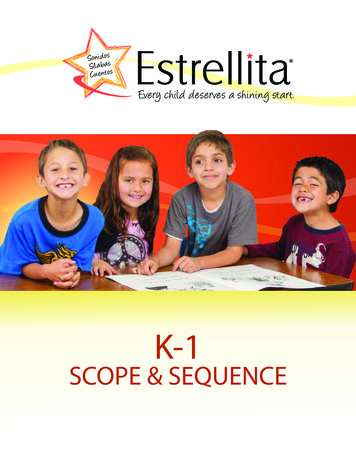
Transcription
K-1SCOPE & SEQUENCE
Estrellita delivers a streamlined curriculum, utilizing an evidence-based, systematic, and accelerated approach toensure quality teaching for successful learning. This approach guarantees a rigorous and effective Beginning SpanishReading program that serves as a bridge to English by laying a strong foundation in Spanish literacy. The program is based on scientific learning and reading principles that are aligned with the CaliforniaCommon Core Standards (CCCS) in Spanish: READING STANDARDS: FOUNDATIONAL SKILLS READING STANDARDS FOR LITERATURE READING STANDARDS FOR INFORMATIONAL TEXTS SPEAKING, LISTENING, AND WRITING STANDARDS In addition to meeting the CCCS Standards en Español, Estrellita’s supplemental program meets otherbenchmarks and practices evidenced as critical for students, such as the five effective practices by theNational Reading Panel: Phonological Awareness, Phonics, Fluency, Reading Comprehension andVocabulary Development. Estrellita’s exposure to academic language, vocabulary, language usage and structures, developslanguage awareness for oracy abilities to express ideas in dialogue, interpret literature, andunderstand complex language content. In four to nine months, Estrellita students learn to read and acquire general academic and domainspecific words and phrases. Beginning reading success in the classroom occurs through sharpeningphonemic awareness, letter recognition, and blending abilities, to name a few. Cultural diversity and multilingualism is highly valued. This encourages students to have interculturalunderstanding for a common community and world language skills in aglobalized economy. Strength-based development program with graduated levels of difficulty builds the confidence of newimmigrants while increasing comprehension and reading fluency at advanced levels over traditionalmodels. Literacy in Spanish is a foundation to literacy in English. Direct and field tested program, teaches explicit built-in strategies to provide multi-sensory instructionand meet high expectations for 21st Century skills. Estrellita provides cumulative Spanish language instruction, which has repeatedly shown to provide astrong foundation, especially when student’s native language is Spanish and their L2 performance ison par academically with English immersion programs. (August & Shanahan, 2006: Cobo-Lewis etal., 2002a, 2002b; Oller & Eilers, 2002b, Collier & Thomas, 1992; Cummins, 2000; Escamilla, 1987:Rodriguez, 1988)2 Estrellita includes an Assessment Component, which allows teachers to plan and differentiateinstruction based on student’s results. Daily Monitoring tools are also part of the programs and allowteachers chart student progress.
A SCOPE & SEQUENCE OF EARLY READINGONGOING SKILLS FOR SUCCESSThe Estrellita curriculum incorporates accelerated early reading strategies, using asequential and systemic instructional plan. Anchored in evidence-based research,the California Common Core Standards, and encompassing other high standards,Estrellita is a demanding yet supportive academic program.Field tested in the classroom, Estrellita’s language acquisition development is efficient, clear, and strength-based toensure California Common Core Standards en Español and other high expectations are implemented. Very youngstudents’ receptive (listening and reading) and productive skills (speaking and writing) are fostered by the Estrellitacurriculum. Home language is used as a resource to secure students’ quick progress and attain high linguisticdemands, allowing the native and heritage language speaker to quickly jump from a beginner to a higher level.These results support the overwhelming amount of research showing that when students learn academic languagesubjects in their native language, learners surpass their peers in monolingual models and continue achievingexcellence in later years, including in English (Thomas & Collier, 1997; Short, 2000; Denton et al., 2006; Haynes,2007; Cummings, 2011; Rodriguez, Carrasquillo & Soon-Lee, 2014).Estrellita’s research-based reading program meets the needs of 80% of the General Education Students (tier 1)and monitors progress through a structured program that incorporates placement tests and benchmark assessmenttools. To meet the needs of Tier 2 students, a double dose of Estrellita Instruction is given, along with interventionplans, assessments, and graphs to monitor student progress. For the Tier 3 students that need intensive intervention,the Estrellita Response to Intervention (RTI) program utilizes a multi-level approach to get students back on trackacademically and ensure 100% of students’ needs are met with excellence. Estrellita’s PreK and Kindergarten earlyreading strategies have a well thought out scope and sequence to implement high standards and equal access tolearning opportunities for all students.Following are chart representations and visuals showing how Estrellita achieves Common Core Standardsen Español and ensures proven strategies for success. The Preschool program is oriented toward phonemicawareness for oral language development and the Kindergarten program is phonics oriented. Developing oracyand literacy objectives for high academics with high supports, leads to high success and every student becoming alittle star, an estrellita.3
ESTRELLITA ALIGNMENT WITH COMMON CORESTANDARDS – OVERVIEWSTANDARD – READING FOUNDATION SKILLSESTRELLITA MATERIALS AND ACTIVITIES Sonidos Iniciales Wall Chart Sonidos Iniciales Wall Chart and ChantsSonidos Iniciales Wall Chart and Chants2. Identify own name in print 3. Recognize and “read” familiar words or environmentalprint (e.g. McDonald’s) Palabras Cards and Whole to part Vocabulary CardsPrint conceptsUnderstanding the organization and basic features of print:1. Left-right, top-bottom and page to page2. Recognize that spoken words are represented in writing3. Understand that words are separated by spaces in print4. Recognize and write names, using upper and lower caseletters in addition to first and last nameSílabas Wall ChartsBig Books and Mini books (i.e. Papá, mamá y Ana)Writing Component:DictadosLetter Formation (Tracing and Printing)Student of the Week ActivityPhonological AwarenessDemonstrate understanding of spoken words, syllables, and sounds(phonemes):1. Recognize and produce Rhyming words2. Hear sounds by isolating the syllables, snapping, clapping3. Recognize when words share phonemes (sounds) e.g. /b/as in Bob, boat4. Difference between sounds that are the same and different– rhyming words, environmental sounds.Phonics and Word RecognitionKnow and apply grade-level phonics and word analysis skills indecoding words1. Demonstrate understanding between letter and soundWriting Standards1. Use combination of drawing, dictating and emergent writingto compose opinion pieces (e.g. Mi libro favorito es .)2. Use combination of drawing, dictating and emergent writingto compose information about the topic3. Use combination of drawing, dictating and emergent writingto compose to narrate an event o sequence of eventsSpeaking and Listening1. Comprehension and Collaboration Purposeful academic talk (one-on one, small groups,and large group settings)2. Presentation of knowledge and ideas Formal sharing of information and concepts3. Vocabulary determining word meanings and word sources Acquiring general academic and domain-specificwords and phrases4Sonidos Iniciales Hand SignalsPreparatory Blending ActivitiesLas Sílabas Wall ChartSonidos Iniciales Wall CardsPicture and Letter CardsPalabras para estudiar en la casaOraciones para estudiar en la casaColor coded Pocket Chart Cards ActivitiesMi Cuaderno de los Sonidos Iniciales (tool formonitoring and evaluating) Estrellita Writing Guide Sonidos Iniciales ChantsCreative WritingReading and writing short storiesStudent of the Week ActivityWorking with SentencesComprehension questionsPartner ReadingColor coded Pocket Chart Cards ActivitiesRetelling ActivitiesMini books (i.e. Papá, mamá y Ana)Big BooksStudent of the Week StoriesSonidos Iniciales CD
ESTRELLITA ALIGNMENT WITH THE COMMON CORESTANDARDS – ACTIVITIES AND ASSESSMENTCOMMON CORE STANDARDSPhonological AwarenessDemonstrate understanding of spokenwords, syllables and sounds, rhymingwords, blending, multiple syllables,isolating of initial soundsVocabulary Acquisition and UseAcquire and use accurately a range ofgeneral academic and domain-specificwords and phrasesESTRELLITA ACTIVITIESESTRELLITA ASSESSMENTSonidos Iniciales Wall Chart,chant, hand signalBenchmark and Placement assessmenttesting (first 2 weeks of school).Preparatory Blending ActivitiesSílabas Wall Charts, Sílabas Cards,Mi Cuaderno de los Sonidos Iniciales,Palabras and Oraciones para estudiar enla casa, Hands on activitiesSmall Group InstructionSIMS - On going, daily monitoringSonidos Iniciales Wall Chart and PicturesWhole to Part Vocabulary CardsDaily monitoringBig Books and Mini BooksSIMSPalabras CardsInformal assessment using Color codedpocket chart cardsPalabras and Oraciones para estudiaren la casaSonidos Iniciales Whole Group ActivitiesSpeaking and ListeningStudent of the week ActivityComprehension & Collaboration skillsBig Books – ComprehensionOngoing formal and informal assessment,Daily monitoringWriting productsKinesthetic ActivitiesLas Sílabas Wall ChartsPhonics and Word RecognitionBlending con a, ae, aei, etc.Know and apply grade level phonicsand word analysis skills in decodingwords both in isolation and in textWhole to Part Vocabulary CardsOngoing formal and informal assessmentincluded in programPalabras CardsIndividual assessment of skillsHands on Activities (Mini books)Big Books (i.e. Papá, mama y Ana)FluencyRead emergent-reader texts withpurpose and understandingPalabras and Oraciones para estudiarven la casaOngoing formal and informal assessmentincluded in programMini-books and related activitiesIndividual assessment of skillsBig BooksBenchmark Assessment / ComprehensionComprehension questionsLanguage StandardsPrint upper and lower case letters,understand and use question words,produce and expand completesentences, demonstrate commandof the conventionsWriting Component, tracing and printinglower and upper case lettersHands on activities (pocket chart cards)Student of the week ActivitySIMS*Writing Blackline MastersDaily monitoringWriting productsOral Language / Teacher observations* SIMS (Sonidos Individualized Management System)5
FOCUS ON THE STRATEGIES TO ENSURE STUDENTACHIEVEMENTESTRELLITA STRATEGIES THAT ALIGN WITH THE COMMON CORE INCLUDE:6ÌÌPictures and SoundsÌÌPrint ConceptsÌÌPhonological AwarenessÌÌPhonics and Word RecognitionÌÌFluencyÌÌComprehension and Collaboration SkillsÌÌDecoding SkillsÌÌBlendingÌÌAsking and answering questions to express thoughts about a textÌÌKey ideas and Details to Retell Familiar StoriesÌÌCraft and StructureÌÌIntegration of Knowledge and IdeasÌÌPresentation of Knowledge and IdeasÌÌRange of Reading and Level of Text ComplexityÌÌResponding to LiteratureÌÌIdentify characters, settings, and key eventsÌÌRecognize texts and identifying author and illustrators role in storyÌÌUnderstand, predict, and infer based on illustrations and textÌÌFoundational skills to compare and contrast characters in familiar storiesÌÌMonitor, clarify, question, and summarizeÌÌReading, speaking, and listening skills through unit lessons
SCOPE – HOW ESTRELLITA IS ALIGNED WITH THECOMMON CORE STANDARDS IN KINDERGARTENThe Estrellita Kindergarten Program demonstrates Common Core Standards throughfoundational skills such as print concepts, phonological awareness, phonics, wordrecognition, oracy, and high-level fluency.The program ensures oral and reading standards for literature, where students learn key ideas and details, articulatedcraft and structure, integration of knowledge and ideas, and have a range of complex reading levels. A focus oninitial sounds (Sonidos Iniciales), syllables, sentences, and stories using a-e-i-o-u, allows students acceleratedreading and writing mastery.BUILDING ON THE PRINT AND PHONOLOGICAL AWARENESS ABILITIES TAUGHT IN PRESCHOOL, INKINDERGARTEN STUDENTS LEARN THE FOLLOWING ACTIVITIES: Recognize and produce rhyming words Count, pronounce, blend, and segment syllables in spoken words Blend and segment onsets and rhymes of single-syllable spoken words. Add or substitute individual sounds (phonemes) in simple, one-syllable words to make new wordsFirst grade-level phonics and word analysis skills to decode are demonstrated through a one-on-one letter-soundcorrespondence, producing the primary or frequent sounds for each consonant, and associating the long and shortsounds with common spellings. Emergent reader texts is taught with purpose and understanding to strengthenstudents’ fluency.Questions are asked and answered about key details in a text, familiar stories are retold using these key details andcharacters are identified, along with settings and major events in a story. Students also learn to identify multiplemeanings for one word; they learn craft and structure through asking and answering questions about unknownwords in a text, recognizing familiar words and common types of texts such as storybooks and poems, anddescribing the relationship between author and illustrator. The role of Illustrations and particular points of the storyare identified, defined, and integrated with other stories so that students can write and speak about subjects wisely;in addition, the following integration of knowledge and ideas are included with prompting and support: Comparison and contrast of the adventures and experiences of characters in familiar stories toanswer questions Cultural connections to texts and self to solve problems efficientlyLevel of text complexity actively engages students in reading activities with purpose and understanding in orderto be able to solve problems, explain author’s reasoning, and speak and write well about topics studied. Priorknowledge about group reading is activated, and the context of a story (written and illustrated) allows students tomake predictions.7
Through Estrellita Units such as sentences and stories with different vowel sounds, the Common Core StateStandards of comprehension and collaboration, presentation of knowledge and ideas, and foundational learningobjectives, students accomplish the following: Participate in collaborative conversations with diverse partners to confirm understanding of a textread aloud, oral presentation, and other media with peers and adults Oral directions are understood and followed. Continue a conversation through multiple exchanges Cultural Competency is highlighted and students learn to understand and communicate with otherstudents from diverse cultural backgrounds Students can ask and answer questions to get information or clarify/seek help when something is notunderstood Students are prepared to speak audibly and clearly express thoughts, feelings, and ideasEstrellita encourages students to draw, dictate, and write simple sentences that they learn. Drawings,visual displays, and descriptions in the Estrellita curriculum, allow students to express and presenttheir work with detail and interest.8
ESTRELLITA – SCOPE & SEQUENCE KINDERGARTENSKILLS DEVELOPEDPRIMARYREADING AGES4-6STRATEGIESPhonological AwarenessRhyming*Use Palabras Cards, and physical objects as well as chants, included inthe program, to identify and generate rhymesIdentifying Beginning sounds*Use of realia to identify each character/picture. Use of unique EstrellitaSonidos Iniciales Wall chart and Hand Signals.Blending sounds*Chanting from the Individual Sílabas Wall Charts, use of Las SílabasColor-coded cards, oral practiceBlending syllables*Chanting from the Individual Sílabas Wall Charts, use of PalabrasColor-coded cards, oral practice, Palabras Cards and Whole to PartVocabulary CardsUse of Palabras cards and Color coded pocket chart cards.PhonicsSIMS, Sonidos Iniciales Wall Charts, CD,Letter-sound correspondence*Identify beginning and endingsounds and letters*Sonidos Iniciales Wall Chart, Use of color coded pocket Chart Cardsand Preparatory Blending Activities (clap, identify)Segmenting, blending andmanipulating soundswith letters*Individual Sílabas Wall Charts, Use of color coded pocket Chart Cardsand Preparatory Blending Activities (clap, identify)Forming two syllable words*Palabras hands on activities, use of blackline masters, Sílabas Wall ChartsSpiral review, letter sound practice is assessed in ongoing formal andinformal settings; assessment guides are included in program.Comprehension*Each word is introduced with visual support, use of Palabras Cards,Whole to Part Vocabulary Cards, Big Books*Page by page comprehension questions from Blooms accompanies eachbig book. Other strategies built into the TE.Comprehension of phrases,sentences and paragraphs*Each word, phrase and sentence comes with built in comprehensionquestions to enhance the conceptual understanding.Concepts of Print*Visual guides and pocket chart cards provided in program; Writingpractice booklet, charting activities.Comprehending wordsCategorical thinkingUsing Blooms TaxonomySight WordsPre-primer sight wordsK-3 grades*Sight words are introduced incidentally in the stories, chants and bigbooks. Palabras Cards will contain sight words.WritingLetter Formation*Practice books include all Estrellita Sonidos with visual support and athome practice activities.Dictado – Interactive writing*Teacher’s Guide gives day by day directions.9
ESTRELLITA – RESEARCH & PEDAGOGY atamoscas(out of order &isolate sounds)-hand signals- Audio c (and chants) trigger“emotional expression”and is “associated with notonly skill-building but alsothe evolution of [students’]language discrimination,mathematical ability, andproblem-solving skills”(Campbell & Scott-Kassner,2014)“This approach helpschildren into long-termmemory” (ibid, p. 253).“Kinesthetic actions helpenergize students by sendingmore oxygen and glucoseto the brain” (Gregory &Chapman, 2013, p. JAMINBLOOMDuring theseactivities, askquestions toproduce higherorder thinkingskills: remembering understandingMovement “is inescapablylinked to learning andmemory” (Sousa, D.A.,2011) and “involves more ofa student’s brain than doesseatwork since movementaccesses multiple memorysystem” (Jensen, 2001).LEARNINGMODALITIESBASIC EDUCATIONSTRATEGY/PRACTICESPhonemic AwarenessVocabulary DevelopmentChoral ReadingEcho ReadingAuditoryPicture ingImagery applying analyzing evaluatingFlexible GroupingGrapheme /Phoneme-Socialization Skills“Not only does movementincrease cognitive function,but it also helps students useup some kinesthetic energyso they can concentratebetter later”(Sousa, D.A., atamosca(out of order)10“Phonological awarenessin Spanish indicates aneffect on performance forphonological awarenesstasks in English. Resultssuggest strengthening thelanguage and metalinguisticskills of children in theirfirst language as a tool forlater acquiring Englishliteracy skills” (Lopez &Greenfield, 2004).“Sensitivity to syllables inSpanish may be particularlyimportant for later readingsuccess ”(Denton et al, luencySpatialKinestheticHierarchy learning
RiddlesCheersStoryCards buildacademicbackgroundknowlegeGames andCenters“In early years, it isvital to provide richverbal stimulation forconnections (synapses)to form between thebillions of neurons in thebrain” (Alison ElliottEvery Child, 2007)“Cheers provide aphysical boost to thebrain. The physical actionsends oxygen and glucoseto the brain” (Gregory &Chapman, 2013)“Narrative-chainingmethod has been shown tobe far superior to ordinaryrote memorization”(Wolf, 2010). “Studentswho used the narrativechaining mnemonicstrategy [like items to beremembered into a storyframework] later recalledmore than 90% of the 120unrelated words comparedto a control group whoremembered only 13%(McGee & Wilson, 1984;Wolf, 2010)“Play Provides a relaxedatmosphere in whichlearning can easily occur”(Piaget, 1951, 1962;Bruner 1972; SuttonSmith, 1967; Hughes,2010 p. 26)RhymingInterper sonalAuditoryProblem nter- TactileWhole Body LearningGross MotorDevelopmentRhymingPhonemic ead ated InstructionVisualProblem SolvingKinestheticApplication11
ESTRELLITA – SEQUENCE FOR THE K-1 PROGRAMWEEK1-23-45-6Unit ofStudyIntroduction toSegment #1Segment #2Los sonidos inicialesVowelsm, p, s, l10 days10 days7 daysPacingGuide Chanting the Sonidos Chanting the Sonidos Chanting the Sonidos Teach the hand signals Use different modalities Teach the hand signals Segment # 1 Use Picture and Letter Chant the hand signals Segment # 2 Use Picture and Letter Cards,Iniciales chartDailyActivitiesof “Canto de los sonidosiniciales CD”Iniciales chartCards, first withpicture, then without SIMS – Mi Cuadernode los SonidosIniciales, Segment 1 Mi Libro de SonidosIniciales chartfirst with picture, then without SIMS – Mi Cuaderno de losSonidos Iniciales, Segment 2 Mi Libro de Sonidospara Colorearpara ColorearSpelling DictationWritingActivitiesCreative WritingTracing and PrintingLowercaseCreative ng DictationTracing and Printing LowercaseCreative WritingSonidos Iniciales Wall Chart,Audio CDSonidos Iniciales Wall Chart,Audio CD, Picture and LetterCards, Mi Libro de Sonidos,Mi Cuaderno.Sonidos Iniciales Wall Chart, Audio CD,Picture and Letter Cards, Mi Libro deSonidos, Mi Cuaderno.Use the Sonidos InicialesWall CardsUse the Sonidos Wall CardsUse the Sonidos Wall CardsAdditional Sonidos ActivitiesAdditional Sonidos ActivitiesParent Packet – Segment 1Parent Packet – Segment 2Additional Sonidos Activities
WEEK6-77-88-9Unit ofStudySegment #3Segment #4Segment #5Review: first columnt, d, r, cReview: 1st column and t, d, r, cPacingGuide5 days7 days6 days Chanting the Sonidos Chanting the Sonidos Chanting the Sonidos Chant the hand signals Segment # 3 Use Picture and Letter Chant the hand signals Segment # 4 Use Picture and Letter Chant the hand signals Segment # 5 Use Picture and Letter Cards, first SIMS – Mi Cuaderno SIMS – Mi Cuaderno Mi Libro de Sonidos Mi Libro de SonidosIniciales chartDailyActivitiesCards, first withpicture, then withoutde los SonidosIniciales, Segment 3para ColorearIniciales chartCards, first withpicture, then withoutde los SonidosIniciales, Segment 4para Colorear Chanting the SílabasIniciales chartwith picture, then without SIMS – Mi Cuaderno de losSonidos Iniciales, Segment 5 Mi Libro de Sonidospara Colorear Chanting the Sílabas con “a” Preparatory Blending Activitiescon “a” Preparatory alActivitiesHomeworkSpelling DictationSpelling DictationTracing and PrintingLowercaseTracing and PrintingLowercaseCreative Writing,Creative Writing,Sonidos Iniciales Wall Chart,Audio CD, Picture and LetterCards, Mi Libro de Sonidos,Mi Cuaderno.Sonidos Iniciales WallChart, Audio CD, Pictureand Letter Cards, Mi Librode Sonidos, Mi Cuaderno.,Sílabas con a chartSonidos Iniciales Wall Chart, Audio CD,Picture and Letter Cards, Mi Libro deSonidos, Mi Cuaderno., Sílabas con achartUse the Sonidos InicialesWall CardsUse the Sonidos Iniciales WallCardsUse the Sonidos Iniciales Wall CardsAdditional Sonidos ActivitiesAdditional Sonidos ActivitiesSpelling DictationTracing and Printing LowercaseCreative Writing,Additional Sonidos ActivitiesParent Packet – Segment 413
WEEK1010-1111-12Unit ofStudySegment #6Segment #7Segment #8n, f, b, jReview: 2nd columnReview: 1st and 2nd column4 days4 days5 daysPacingGuide Chanting the Sonidos Chanting the Sonidos Chanting the Sonidos Chant the hand signals Segment # 6 Use Picture and Letter Chant the hand signals Segment # 7 Use Picture and Letter Chant the hand signals Segment # 8 Use Picture and Letter SIMS – Mi Cuaderno SIMS – Mi Cuaderno SIMS – Mi Cuaderno Mi Libro de Sonidos Mi Libro de Sonidos Mi Libro de Sonidos Chanting the Sílabas Chanting the Sílabas Chanting the Sílabas Preparatory Blending Preparatory Blending Preparatory BlendingIniciales chartCards, first withpicture, then withoutDailyActivitiesde los SonidosIniciales, Segment 6para Colorearcon lActivitiesHomework14Iniciales chartCards, first withpicture, then withoutde los SonidosIniciales, Segment 7para Colorearcon “a”ActivitiesIniciales chartCards, first withpicture, then withoutde los SonidosIniciales, Segment 8para Colorearcon “a”ActivitiesSpelling DictationSpelling DictationTracing and PrintingLowercaseTracing and PrintingLowercaseCreative WritingCreative WritingSonidos Iniciales WallChart, Audio CD, Pictureand Letter Cards, Mi Librode Sonidos, Mi Cuaderno.,Sílabas con a chartSonidos Iniciales Wall Chart,Audio CD, Picture and LetterCards, Mi Libro de Sonidos,Mi Cuaderno., Sílabas cona chartSonidos Iniciales Wall Chart, Audio CD,Picture and Letter Cards, Mi Libro deSonidos, Mi Cuaderno., Sílabas con achartUse the Sonidos InicialesWall CardsUse the Sonidos Iniciales Wall CardsUse the Sonidos InicialesWall CardsAdditional SonidosActivitiesParent Packet – Segment 6Additional Sonidos ActivitiesSpelling DictationTracing and Printing LowercaseCreative WritingAdditional Sonidos Activities
WEEK12-13Unit ofStudySegment #9g, ch, ñ, v, ll7 days5 days Chanting the SonidosIniciales chartCards, first withpicture, then withoutCards, first withpicture, then without SIMS – Mi Cuaderno SIMS – Mi Cuadernopara Colorear Chanting the Sílabascon “a” Preparatory orkIniciales chart Chant the hand signals Segment # 10 Use Picture and Letter Mi Libro de SonidosWritingActivities Chanting the Sonidos Chant the hand signals Segment # 9 Use Picture and Letterde los SonidosIniciales, Segment 915-16Segment #10Review: 1st, 2nd and 3rdcolumnsPacingGuideDailyActivities14de los SonidosIniciales, Segment 10 Mi Libro de Sonidospara Colorear Chanting the SílabasSegment #114th column6 days Chanting the Sonidos Inicialeschart Chant the hand signals Segment # 11 Use Picture and Letter Cards,first with picture, then without SIMS – Mi Cuaderno de losSonidos Iniciales, Segment 11 Mi Libro de Sonidos paraColorear Chanting the Sílabas con “a” Preparatory Blending Activitiescon “a” Preparatory BlendingActivitiesSpelling DictationSpelling DictationTracing and PrintingLowercaseTracing and PrintingLowercaseCreative WritingCreative WritingSonidos Iniciales WallChart, Audio CD, Pictureand Letter Cards, Mi Librode Sonidos, Mi Cuaderno.,Sílabas con a chartSonidos Iniciales WallChart, Audio CD, Pictureand Letter Cards, Mi Librode Sonidos, Mi Cuaderno.,Sílabas con a chartSonidos Iniciales Wall Chart, Audio CD,Picture and Letter Cards, Mi Libro deSonidos, Mi Cuaderno., Sílabas con a chartUse the Sonidos InicialesWall CardsUse the Sonidos InicialesWall CardsUse the Sonidos Iniciales Wall CardsAdditional Sonidos ActivitiesAdditional Sonidos ActivitiesParent Packet – Segment 9Spelling DictationTracing and Printing LowercaseCreative WritingAdditional Sonidos ActivitiesParent Packet – Segment 1115
WEEK16Unit ofStudySegment #12Review: All columnsPacingGuide18-19-20Sílabas con aPalabras con a5 days15 days4 days Chanting the SonidosIniciales chart Chant the hand signals Segment # 12 Use Picture and LetterCards, first with picture,then withoutDailyActivities17 SIMS – Mi Cuadernode los Sonidos Iniciales,Segment 12 Mi Libro de Sonidospara Colorear Chanting the Sílabascon “a” Preparatory Blending Chanting the Sílabascon “a” Preparatory BlendingActivities Sílabas con “a” Pre-Test Guided Practice Segmentation ofSyllables into Phonemes Individual DailyMonitoring Using Sílabas con“a” cards Record student progressusing Blending ProgressChart and Class RecordActivitiesSpelling DictationWritingActivitiesTracing and PrintingLowercaseCreative s Iniciales WallChart, Audio CD, Pictureand Letter Cards, Mi Librode Sonidos, Mi Cuaderno.,Sílabas con a chartUse the SonidosIniciales Wall CardsAdditional SonidosActivities Pre-test each student Use Palabras con a paraestudiar en la casa forpartner reading, guidedreading,group-assisted reading. Use Color-coded PocketChart Cards to modelblending syllablestogether to form words Palabras con “a” cards Individual DailyMonitoring Palabras con “a” cards Record student progressusing Blending ProgressChart and Class RecordSpelling DictationSpelling DictationCreative WritingCreative WritingStudent of the WeekStudent of the WeekSílabas con a Wall Chart,Sílabas con a Cards,Concrete objects to modelblending, Blending ProgressChart and Class RecordSílabas con a Wall Chart, Palabras con aCards, K-1 Palabras con “a” cards, BlendingProgress Chart and Class RecordSupplementaryActivitiesSupplementary ActivitiesBlending ActivitiesSílabas con a reviewPalabras BooksPalabras con a para estudiar enla casa, Reading Slips
WEEK21-22-23Unit ofStudyOraciones con aPacingGuide15 daysIntroduce the sentences and ask comprehension questionsUse Oraciones con a para estudiar en la casa for partner reading, guided reading, groupassisted reading. Count words in a sentenceUse Color-coded Pocket Chart Cards to model using words to form sentencesUse Palabras con “a” cardsAssessment, Sentence Decoding and FluencyRecord student progress using Blending Progress C
ensure quality teaching for successful learning. This approach guarantees a rigorous and effective Beginning Spanish Reading program that serves as a bridge to English by laying a strong foundation in Spanish literacy. The program is based on scientific learning an
